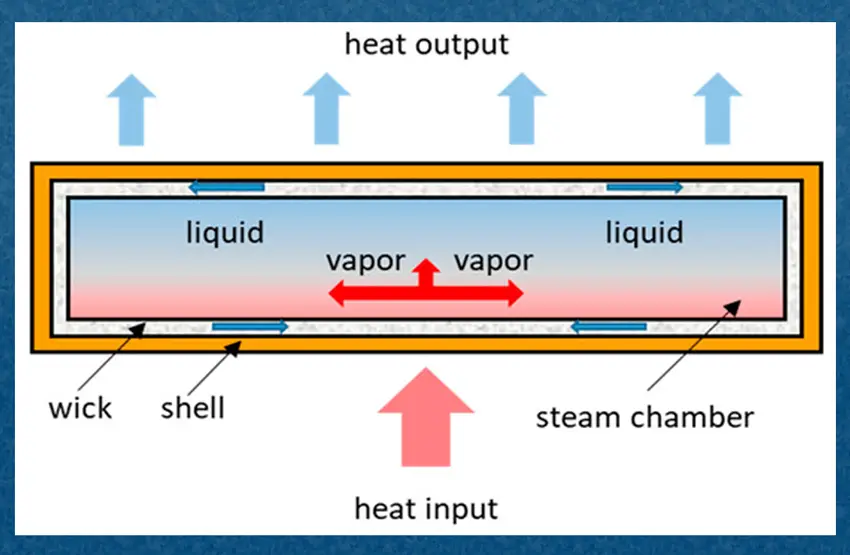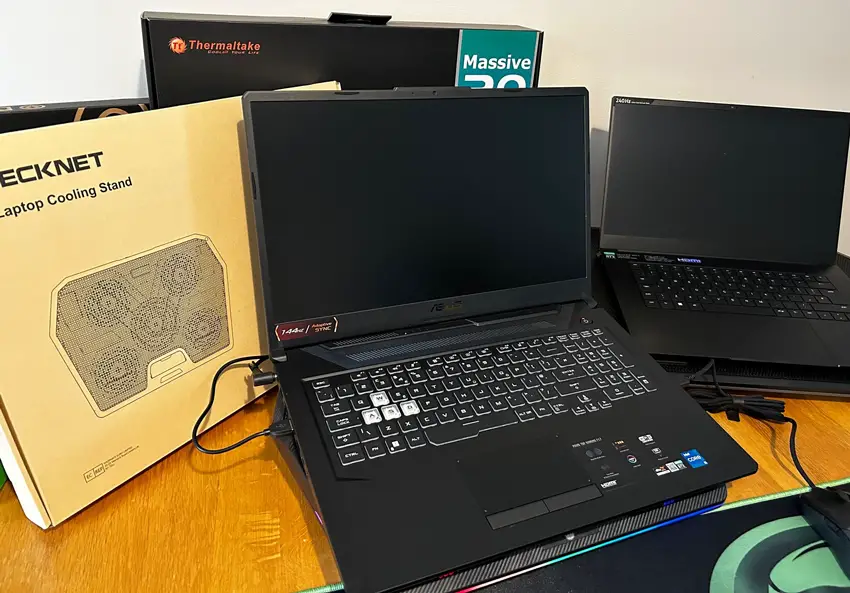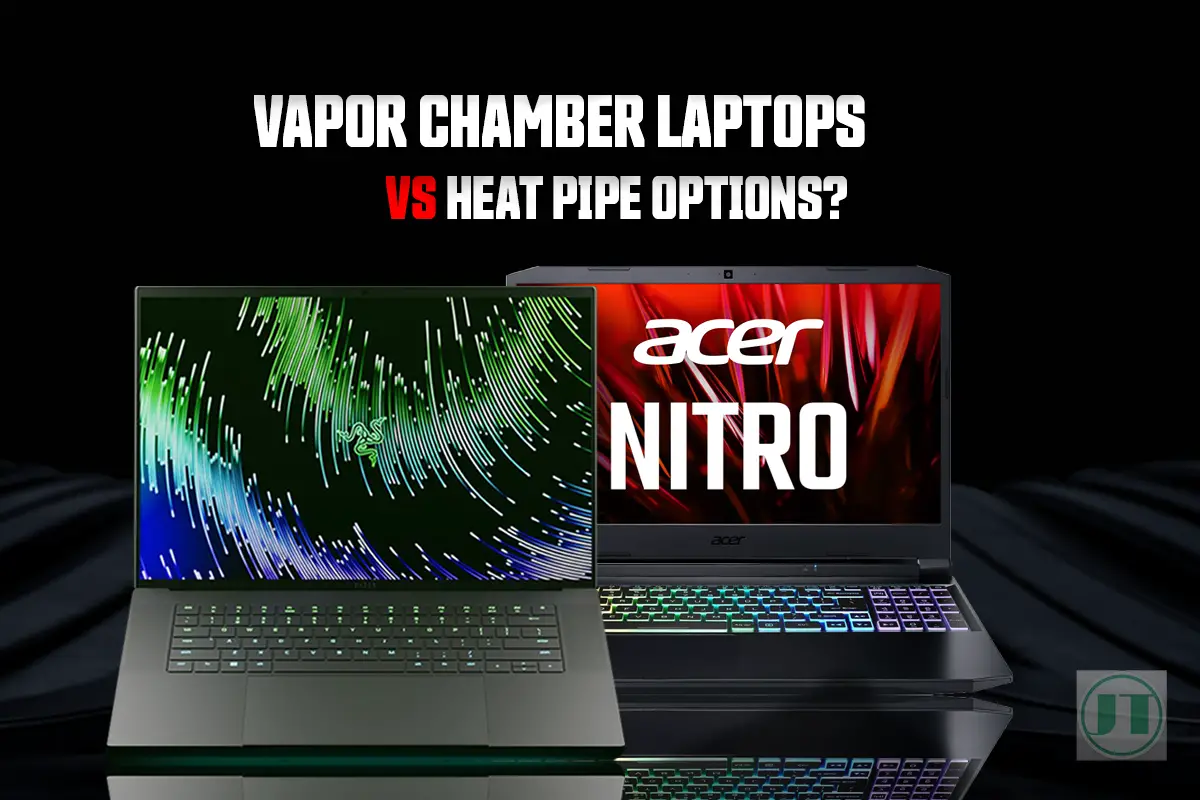In the world of high-performance gaming laptops, an effective cooling system is crucial. That’s where comparing vapor chambers vs heat pipe laptops come into play. These advanced cooling solutions are the two main revolutionizing ways laptops use to dissipate heat.
Both vapor chambers and heat pipes act as efficient conduits, transferring excess heat away from vital components such as processors and graphics cards. These cutting-edge technologies provide superior thermal management for the latest gaming notebooks.
But what’s the difference between these two thermal resistance systems? Which gaming laptop should you choose? Keep reading as we dive into the benefits, and differences between these two commonly used laptop cooling system technologies.
Vapor Chambers Vs Heat Pipe Laptop Computers
Heat pipes and vapor chambers are two popular methods used for heat transfer in laptops. While the fundamentals of heat pipes and vapor chambers are the same, relying on phase change of liquid to increase their thermal conductivity, both serving the purpose of dissipating heat from high heat fluxes generated by the CPU and GPU. But have distinct differences in terms of design and performance.
Understanding these key differences between these two types of computer cooling systems can help users make an informed decision when choosing a laptop designed for gaming. Especially when looking for a laptop with the most efficient cooling capabilities.

Structure and Design
One fundamental difference between vapor chamber and heat pipe laptop cooling systems lies in their structure. Heat pipes consist of sealed copper tube(s) with a wick structure inside. The copper tubes are filled with liquid, which evaporates at the hot end (over the CPU/GPU) and condenses at the cooler end. Transferring heat by the movement of liquid-phase coolant.
Vapor chambers have a flat hollow chamber filled with liquid. The evaporator section is directly over the heat source, while the condenser section is over cooler areas like fins. The design contains multiple layers, including wicks, working fluid, and a top cover.
Heat Spreading Capabilities
Vapor chambers outperform heat pipes in terms of heat spreading capabilities. The flat plate design allows for better thermal conductivity across the entire chamber compared to the limited area coverage provided by heat pipes.

Vapor chamber cooling systems spread heat in two directions and heat pipe solutions are only able to spread heat in one. The enhanced spreading capability of a vapour chamber laptop ensures that hotspots are minimized on critical components like the CPU and GPU.

Flexibility vs Rigidity
Heat pipes offer more flexibility compared to vapor chambers due to their tubular structure. Copper pipes can be shaped according to the space within a laptop chassis, making the heat pipe cooling solution perfect for compact laptop designs or smaller laptops.
In contrast, vapor chambers are rigid structures that cannot be easily manipulated or bent, which restricts their application in gaming laptops with tight form factors. However, vapor chambers are ideal for larger devices where space is not as constrained.
However, gaming laptop brands like Razer and ASUS have designed ultra compact devices like the Razer Blade 14 or the ROG Flow Z13 with vapor chamber cooling systems.
Thermal Conductivity
Vapor chambers provide higher thermal conductivity than heat pipes due to their advanced design. The multiple layers within a vapor chamber enable efficient transfer of heat from the source towards the edges of the chamber where the heat can be dissipated more effectively.
Through an attached heat sink or dual cooling fans, this superior thermal conductivity of vapor chambers ensures efficient laptop cooling even under demanding workloads like gaming.
In summary, vapor chambers are better for cooling small, concentrated hot spots like a CPU die, while heat pipes can transfer heat longer distances but have lower conductivity. For a gaming laptop with high CPU/GPU heat, a vapor chamber design would provide the best cooling performance.

Based solely on the cooling system and thermal performance listed above, (data Notebookcheck) here are the laptops that stand out:
- Asus ROG Zephyrus G14 – Very low noise levels even under load and excellent heat dissipation with low bottom temps around 28C idle.
- Asus ROG Flow Z13 – Extremely low bottom temps around 26C idle and under 60C load, along with fast response times. Suggests highly effective vapor chamber cooling.
- Razer Blade 16 with RTX 4090 – Lower than average noise levels during gaming and able to handle the heat generated by the NVidia RTX 4090.
- Lenovo Legion 7 – Solid thermals and noise levels point to a balanced and capable cooling system. (vapor chamber cooling)
- MSI Stealth 17 Studio – Low noise levels indicates an efficient cooling system.
The Asus Zephyrus G14, ROG Flow Z13, Razer Blade 16, Lenovo Legion 7, and MSI Stealth 17 stand out based on their thermal performance. These are all powerful gaming notebooks that feature the vapor chamber cooling system.
Further Reading: See why the cooling system is important for a laptop computer and how the thermal system impacts performance and longevity of a device.
Benefits of Vapor Chamber Cooling Technology
Vapor chamber cooling laptops offers numerous benefits for gamers and content creators, such as enhanced thermal performance, stability and reliability, reduced hotspots on the laptop’s surface, and enabling thinner designs without compromising on cooling efficiency.
Enhanced Thermal Performance
One of the key advantages of vapor chamber cooling is the ability to efficiently dissipate heat. Unlike traditional heat pipe devices that rely on copper tubes to transfer heat away from the source, vapor chambers utilize a sealed chamber filled with a small amount of liquid coolant.
The design of vapor chamber cooling systems allows for better distribution of heat across a larger surface area within the chamber. By evenly spreading the heat generated by a gaming laptop’s core components, it prevents localized hotspots from forming.
This leads to more effective cooling performance and ensures that critical components like the CPU and GPU stay within safe operating temperatures during demanding tasks.
Improved Stability and Reliability
Maintaining lower operating temperatures is crucial for ensuring the stability and longevity of a gaming computer and especially laptops. With vapor chamber cooling technology, laptops can achieve this goal more effectively compared to conventional cooling methods.
By efficiently dissipating heat, the vapor chamber cooling system helps prevent overheating issues that can lead to system instability or worse, component failures.
All this results in a more reliable device that can handle prolonged usage without compromising performance or risking damage due to excessive heat build-up.
Reduced Hotspots
Traditional laptops often suffer from hotspots on their surfaces where concentrated areas of heat accumulate. These hotspots not only make using the laptop uncomfortable but also pose potential risks if they exceed certain temperature thresholds.
The vapor chamber cooling system helps mitigate this problem by spreading out the generated heat across a larger area within the chamber. As a result, there are fewer hotspots on the laptop’s surface, making it more comfortable to use during operation.
Thinner Laptop Designs
Another advantage offered by vapor chamber cooling is its ability to enable thinner laptop designs without sacrificing cooling efficiency. The compact and efficient nature of vapor chambers allows for more flexibility in the overall design of the notebook.

By utilizing vapor chamber technology, laptop manufacturers such as Razer, during the manufacturing process can create thinner and lighter devices while still maintaining optimal cooling performance. Which is beneficial for users who prioritize portability and sleek aesthetics without compromising on their laptop’s ability to handle demanding tasks.
Limitations of Vapor Chamber Cooling Technology
One of the main limitations of vapor chamber cooling technology is the higher cost of implementing the cooling system in laptops compared to traditional heat pipe solutions.
Vapor chamber cooling systems are more expensive to manufacture due to complex designs. The intricate nature of the evaporator, which helps enable efficient thermal management, requires specialized equipment and expertise, driving up the overall cost.
In budget-friendly gaming laptops, where cost optimization is crucial, vapor cooling technology may not be used. Manufacturers such as ASUS with the ASUS TUF range of budget laptops opt for heat pipe systems as a more affordable alternative. These limitations restrict the availability of vapor chamber cooling in entry-level gaming notebooks.

Manufacturing Complexities Affecting Availability
The manufacturing complexities associated with vapor chamber cooling also affect the cooling system’s availability in laptops. The process involves creating a sealed chamber filled with a working fluid that undergoes phase change to transfer heat effectively. These chambers need to be precisely designed and manufactured to ensure optimal performance.
Due to these complexities, not all laptop manufacturers have the capability or resources to incorporate vapor chambers into their designs. As a result, only select high-end laptops or gaming machines feature the advanced vapor cooling system.
Design Considerations for Optimal Performance
To achieve optimal performance, proper design considerations are essential when implementing vapor chamber cooling technology into devices. The placement of the vapor chamber within the laptop chassis significantly impact its effectiveness in dissipating heat.
Laptop manufacturers must carefully plan the layout and airflow management within the laptop design to maximize the benefits of using a vapor chamber. This includes considering factors such as fan positioning, ventilation openings, and thermal interface materials between components like the CPU, GPU, and motherboard and for the vapor chamber itself.
Exploring the Impact of Vapor Chamber Cooling on Performance
Powerful gaming laptops have become an essential tool for both work and play. And their capabilities continue to advance, so does the need for efficient thermal systems. And two popular cooling solutions stand out: vapor chambers and heat pipes. Let’s look at how these two thermal solutions can impact performance, hardware, and device lifespan.
Reduced risk of hardware damage
Excessive heat can wreak havoc on delicate laptop components. Heat pipes are effective at transferring heat away from these parts, but they may struggle when faced with heavy workloads or demanding gaming sessions.
Vapor chambers excel in handling high thermal loads due to their superior conductivity and larger contact area. This enhanced capability significantly reduces the risk of hardware damage caused by prolonged exposure to extreme temperatures.
With vapor chamber cooling, users can enjoy peace of mind knowing that their laptops are protected against potential long-term harm. There is no surprise to learn some of the best laptops with the best cooling systems feature the vapor cooling method.
Enables longer gaming sessions without performance lag
For avid gamers, maintaining optimal performance when playing high intensity video games is crucial. The last thing gamers wants is for their laptop’s frame rates to drop or experience performance lag due to their gaming computers overheating.
Vapor chamber cooling plays a vital role in ensuring uninterrupted gaming experiences by effectively managing thermal dissipation. By efficiently dispersing heat away from critical components, help gaming notebooks sustain peak performance levels even during intense gaming sessions. This means gamers can immerse themselves in their favorite titles for longer periods without worrying about performance degradation.
Enhances overall system stability and longevity
Laptops equipped with vapor chamber cooling not only deliver superior performance but also enhance overall system stability and longevity. By effectively managing heat dissipation, vapor chambers reduce the strain on internal components, leading to improved reliability.
Furthermore, the enhanced cooling capabilities of vapor chambers contribute to a longer lifespan for laptops. Cooler temperatures result in less wear and tear on hardware components, reducing the likelihood of premature failure. This translates to a more durable laptop that can withstand demanding tasks and provide reliable performance for longer.
Pros and Cons of Vapor Chambers
Vapor chambers have become increasingly popular in the field of electronics cooling due to their efficient heat dissipation capabilities. Like any technology, they come with their own set of pros and cons. Let’s take a closer look at the advantages and disadvantages.
| PROS | CONS |
|---|---|
| 1. Efficient Heat Transfer: Vapor chambers provide excellent heat transfer capabilities, allowing for more efficient cooling. | 1. Cost: Vapor chambers can be expensive to manufacture, making them less accessible for budget-conscious projects. |
| 2. Uniform Cooling: Vapor chambers distribute heat evenly across the surfaces, preventing hot spots throughout the device. | 2. Condensation Risk: In certain conditions, vapor chambers may experience condensation, which can potentially damage electronic components. |
| 3. Versatility: Vapor chambers can be customized to fit various shapes and sizes, making them suitable for a wide range of electronic devices and applications. | 3. Manufacturing Complexity: The production process of vapor chambers can be complex and require specialized equipment, which may increase production costs and lead times. |
| 4. Low Thermal Resistance: Vapor chambers offer low thermal resistance, allowing for efficient heat dissipation and improved overall performance. | 4. Limited Availability: Vapor chambers may not be readily available in all regions, which can pose challenges for procurement and sourcing. |
| 5. Reliability: Vapor chambers have a long lifespan and are highly reliable. |
It’s important to carefully consider the pros and cons of vapor chambers before incorporating them into electronic devices or cooling systems. While they offer efficient heat transfer and uniform cooling, laptops with vapor chamber cooling are often more costly.
Conclusion
When comparing vapor chamber vs heat pipe laptop cooling, vapor chambers offer improved thermal conductivity and more efficient heat dissipation, making them advantageous for high-performance gaming laptops requiring effective heat management.
However, laptops with vapor chambers can be more expensive than laptops with heatpipe cooling solutions. And their effectiveness depends on factors like laptop design and usage. Yet, despite limitations, the increasing use of vapor chambers in a gaming laptop shows their potential for superior cooling when handling demanding tasks without compromising thermals.
As gamers seek immersive experiences requiring heavy graphics and processing, effective cooling is crucial for optimal performance. Ultimately, if you prioritize top-notch thermal management for intense gaming and can invest in advanced technology, choosing a laptop with a vapor chamber could be worthwhile for a sure fire cooling solution.
Sources: Radian Heat Sinks




